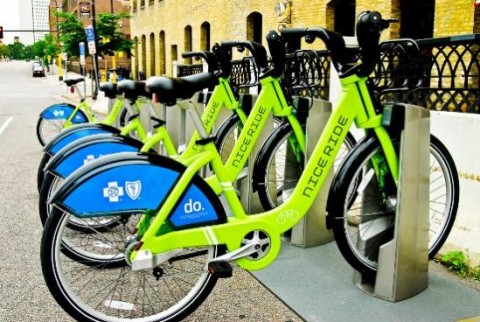
Giddy biking and public policy enthusiasts crowded into Minneapolis' Uptown Theater last night, grabbing pints of Surly brew (in a corn-based compostable cup, no less), and settling in for a panel discussion on "Cities, Bicycles, and the Future of Getting Around," part of a popular "Policy and a Pint" series sponsored by local public radio station 89.3 The Current.
Headlining panelist David Byrne, avid cycling advocate and former Talking Heads frontman, was no doubt causing some of the buzz-I mean, he's David Byrne, for heaven's sake; if you haven't seen Stop Making Sense, stop reading this blog and go. Go now. Do it. But to be fair, Twin Cities cyclists have also had a lot of other things to get excited about lately: Bicycling named Minneapolis the #1 U.S. city for biking, and that was even before last week, when the initial phase of Nice Ride Minnesota, a spectacular public bike sharing program, got off the ground.
Nice Ride co-sponsored the panel, which also included Minneapolis Mayor R.T. Rybak, author Jay Walljasper, and Steve Clark, manager of Transit for Livable Communities' Walking and Bicycling Program. (The men rode cheerful green bike-share cruisers down the aisles of the theater.) So, you might ask yourself, what is the future of cities, bicycles, and getting around?
David Byrne delivered a photo-based powerpoint, beginning with slides of suburbs shot from above and termite high-rises (take note: the insects have a better grip on passive heating than we humans), and transitioned into the alienating, futuristic cities imagined by folks like Hugh Ferriss, Frank Lloyd Wright, and Buckminster Fuller. He also showed also a vintage image featuring a super-mega-highway from General Motors-which at the time, Byrne stressed, was the biggest company on "the whole damn planet." Its vision carried weight.
The evidence of that weight is all over. Byrne began showing photographs from his travels: shots of downtown highway underpasses, barren stretches of road, vacant parking lots, and dead strip malls. "The city is a parking lot," he said, "and when it's not a parking lot, it's a parking structure. This is dead. This is dead life."
Not everywhere, however. The mood shifted as Byrne began flipping through photographs shot both stateside and abroad, rattling off some of the more promising places he's been and things he's seen. New bike parking facilities and protected bike lanes-one in New York that he says has changed his rides for the better. A sensor that clips onto spokes that could be used by employers to track and give credit to employees who commute on two wheels. European town squares, where cars are not prohibited but are so obviously inefficient choices, they're hardly ever seen. And a preteen band playing-not well-on a street corner. He stopped, he said, and listened for a minute, wondering in effect: Is this avant guard? Is their dad hiding just around the corner? But the point is he stopped, a moment he never would have had if he had been traveling by car.
Mayor R.T. Rybak followed Byrne's presentation, raising whoops from the audience by declaring that the city would work to keep the laurel that Bicycling gave it. "Portland is just a street in the city of Minneapolis," he quipped, and then launched into a rapid-fire speech about how Nice Ride came to fruition-and what the city has planned next, including 35 new miles of bike trail.
Up next, writer Jay Walljasper (a former Utne Reader editor, as it were) posited his vision for the future of cycling: "Incredibly sexy and utterly normal." To understand the sexy part, he proposed, think back to Butch Cassidy and the Sundance Kid-that scene where Butch (Paul Newman) gives Etta (Katharine Ross) a ride on his handlebars. (Walljasper imagined thousands of Americans, sitting on their couches, wondering: Now where was that bike again? The garage?)But in all seriousness, he said, biking is sexy: "It's elegant, fun, and will make [you] feel a lot better." The utterly normal part became evident in a gauntlet thrown down to the people who are already biking nuts-to break down the clubbishness and exclusiveness, and make sure that everyone can access the "environmental, social, and spiritual" reasons to ride.
In closing, Steve Clark from Transit for Livable Communities, a nonprofit working to reform Minnesota's transportation system, took the stage. "I do believe our world is changing," he said, "And it's hanging so fast that we can't [appreciate] what's happening." His prediction: 2010 will be recorded in history as the year our love affair with the automobile came to an end.
Clark was a rousing, earnest speaker, pointing out what he sees as the cracks in the foundation of car culture: both oil-related Gulf crises (BP's spill and Iraq), rising rates of asthma, obesity and health issues, and air pollution, to name a few. Federal financial support his organization has received is in a sense groundbreaking, he says, representing government recognition that biking and walking are real parts of a solution to national transportation needs.
Transit for Livable Communities, for example, through its Bike/Walk Twin Cities program, was able to financially support Minnesota Nice Ride, the largest bike-share program in the United States. Clark packaged his take on why bicycles are the future into a tidy and timely acronym:
Nimble. Bikes are a quick and nimble way to get around.
Inviting. Anyone can ride one, and you can do it in regular clothes.
Convivial. On a bike, you interact with people. In a car, you don't.
Efficient. Biking is so efficient, it even beats out walking.
And you know? That really does cover it. Biking is just nice. In every way.
6/18/2010 12:38:06 PM
by Julie Hanus
